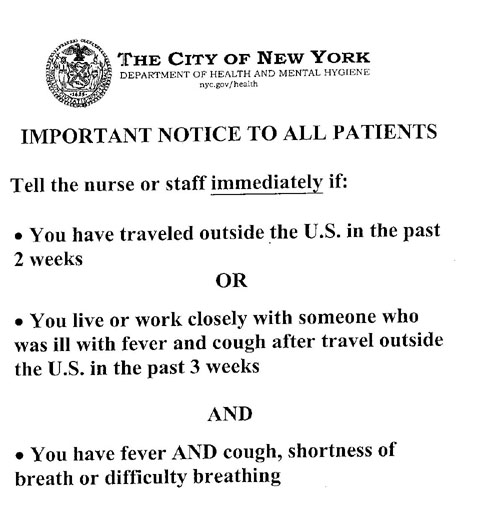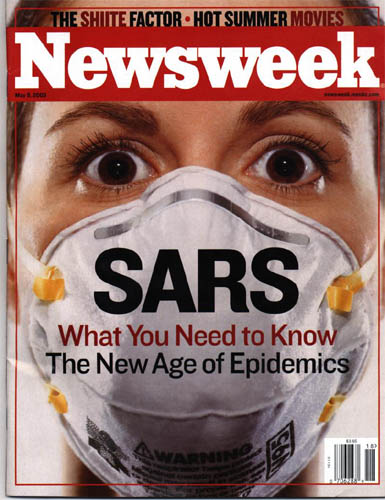
Welcome to the Tesla Memorial Society of New York Website
SARS - A New Mysterious Epidemic
Written by Dr. Ljubo Vujovic M.D., Dr. Mihailo Rundo M.D.
Michael Parrinello FNP, MS, Keith Seims FNP, MSN
(New York, May 3, 2003)

SARS (Severe Acute Respiratory Syndrome) is a viral disease caused by a virus of Corona respiratory viruses affecting mostly respiratory organs which is characterized by a fever (more than 38°C), cough, shortage of breath and underlying atypical pneumonia (inflammation of the lungs). This is a disease which spreads very easily and affecting many people worldwide (over 5,000 people worldwide). The statistics of affected SARS cases are changing rapidly, daily and weekly. It requires considerable epidemiologic and health care measures of many countries and help from the international health organizations to combat the epidemic. The mortality rate is about 6% (from one hundred people affected by the disease, about 6 people die from complications of the disease). The weapons to combat SARS are so far the thermometer to check temperature, a cardinal symptom of SARS, early diagnosis, isolation and quarantine of SARS cases. SARS requires international cooperation in the health field, accurate reporting of cases, reliable and quick diagnosis laboratory tests and coordination of research laboratories worldwide.
The Center for Disease Control and Prevention in the USA will soon begin shipping to laboratories the first experimental laboratory test that may help doctors to diagnosis SARS. The genetic composition of the SARS virus is analyzed and largely known which enables scientists to find a preventive vaccine. The problem with SARS virus is that it is constantly changing its genetic makeup, making the vaccine difficult to produce. The SARS virus is in a way similar to flu virus, which requires a new vaccine every year because the virus changes its genetic makeup frequently. With the vaccine still a year away and few drug treatments on the horizon, quarantine and old-fashioned infection-control practices are the only defense against the virus. It was a very remarkable achievement in Vietnam to stop the spreading of the SARS epidemic in that country with textbook described epidemiological measures which is now being followed by many other countries. Accurate reporting of infected cases is extremely important to combat the spread of infection.
The Incubation period of SARS is 1-2 weeks. The incubation period is the time from first exposure of the virus until the disease symptoms appear. A recent summit for SARS in Bangkok was the first high-level international meeting to discuss the SARS epidemic. Leaders of the summit endorsed a proposal by their health ministers to require pre-departure SARS checks at airports and other ports of entering and leaving the country and to bar travelers with SARS symptoms.
All suspected cases of SARS have to be quarantined in their hospital or in their homes for the period double the incubation time of the disease. In Beijing, Bangkok, Hong Kong and other places in Asia, the schools, universities, theaters, and other entertainment faculties are closed to help contain the spread of this dangerous epidemic. The China government advised people living in Beijing to avoid travel to mainland China in order to prevent the spread of the disease. The face mask, caps, gowns, gloves and eye protection are standard protection barriers from the virus.
More than 5,300 SARS infections have been reported at the end of April 2003 in more than 20 countries so far, the most SARS cases are in China. The global death toll is at least 400, so far and the number climbs. The number of suspected and infected cases of SARS is tiny so far, compared to the 3 million people who died of AIDS last year, the danger of the SARS epidemic is significant.

If SARS continues to spread, its number of infected individuals could sky-rocket. Its over-all death rate is far lower than that of AIDS, Ebola or malaria, however if enough people catch SARS even a low rate can cause a catastrophe. The Spanish flu epidemic of 1918-1919, had a death rate of less than 3% but so many people became infected that it killed more than 20 million people in just 18 months.
SARS originated in China and quickly spread to other Asian countries and many countries around the world with Canada having the most morality cases outside Asia. The disease rocked the Asia market, ruined the tourist trade of the entire region and spread panic to some of the world's largest countries.
In the United States there were 52 probable cases of infection, 11 more than last week. No one in the United States has died from complications of the disease. The mysterious disease spreads very quickly by respiratory secretions, other excretions and close contact with the patient.
The daily newspapers, television, radio, Internet and other media such as Center for Disease Control and Prevention reports had satisfactory, efficiently and accurately informed the public, health care providers and officials about the spread of the disease and measures to be taken on a large-scale to prevent spread of SARS, the mysterious epidemic.
Time Magazine: The Truth about SARS
New York Post: The cost of deadly plague on economy (April 28, 2003)
New York Post: The SARS Crisis (April 28, 2003)
New York Times: The SARS Epidemic (May 3, 2003)